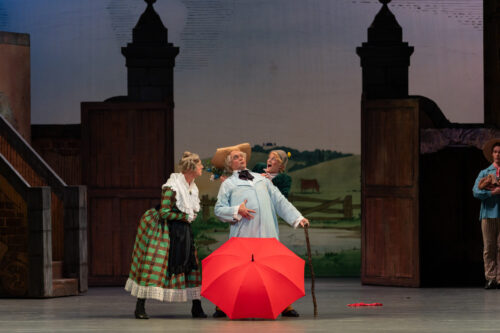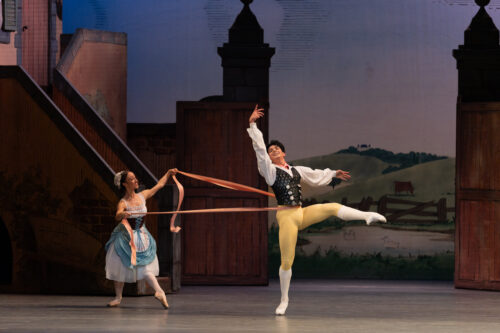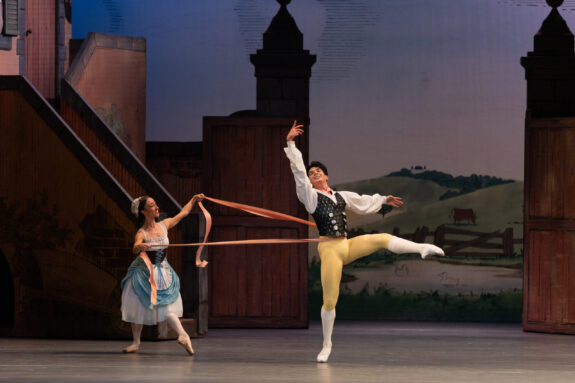 United Kingdom Birmingham Royal Ballet’s La Fille mal gardée: Dancers of Birmingham Royal Ballet, Royal Ballet Sinfonia / Paul Murphy (conductor). Sadler’s Wells, London, 25.10.2024. (JO’D)
United Kingdom Birmingham Royal Ballet’s La Fille mal gardée: Dancers of Birmingham Royal Ballet, Royal Ballet Sinfonia / Paul Murphy (conductor). Sadler’s Wells, London, 25.10.2024. (JO’D)

Creatives:
Choreography – Frederick Ashton
Music – Ferdinand Hérold (freely adapted and arranged by John Lanchbery)
Scenario – Jean Dauberval
Designer – Osbert Lancaster
Lighting – Peter Teigen (adapted by Johnny Westall-Eyre)
Cast included:
Lise – Beatrice Parma
Colas – Enrique Bejarano Vidal
Thomas – Jonathan Payn
Alain – Gus Payne
Widow Simone – Rory Mackay
Principals, First Soloists, Soloists, First Artists, Artists of Birmingham Royal Ballet
Created (according to Frederick Ashton’s biographer, David Vaughan) in ‘an atmosphere of great happiness’, La Fille mal gardée would seem to transmit that happiness, over sixty years later, from whatever stage: the Royal Opera House; the Palais Garnier; in this production by Birmingham Royal Ballet, Sadler’s Wells.
It is a production in which the roles of bucolic lovers Lise and Colas are taken by dancers well matched in terms of charm, musicality and technique. Beatrice Parma and Enrique Bejarano Vidal have both made an impression at Sadler’s Wells before. She in the ‘Peasant’ pas de deux of Giselle in 2019. He as Bluebird in The Sleeping Beauty earlier this year. It is a pleasure to see them dance, and act, together now.

Clear and precise in everything she does, Beatrice Parma ‘shows’ you the dance (as Balanchine put it). Enrique Bejarano Vidal’s powerful legs, in their yellow breeches, give him the lusty swagger of a farm labourer, and help him perform the fouetté, sur place. Yet when Colas lowers Lise to the floor from a lift in Act III, then extends his arms as if to protect and cherish her, Vidal sends a delicate ripple of movement outwards from his shoulders that makes the air between the two dancers resonate.
As a counterpoint to the two lovers there is Alain, the vineyard-owner’s son who Lise’s mother wants her to marry. In the programme notes, the dancer Alexander Grant (on whom the role was created) explains that Alain was never meant to be the ‘village idiot’. He is, instead, innocent and unworldly. Gus Payne’s Alain captures the hearts of the audience. Above all at the climax of the ballet when he sits in absolute stillness on the floor, shoulders bowed as he contemplates the brightly sparkling but now useless engagement ring he was meant to offer Lise.
Rory Mackay, en travesti, is a somewhat reined-in Widow Simone (Lise’s mother). This could be in order not to overdo the pantomime dame aspects of the role. And after reading Julie Kavanagh’s biography of Ashton, Secret Muses, it is possible to see something of Ashton’s own mother in Widow Simone. Alone together in their house after the harvest dance, she and Lise bring Ashton and his mother in their Earl’s Court flat to mind.
The music, taken from versions of the ballet in 1789 and 1828, is played at a fast tempo by the Royal Ballet Sinfonia under their conductor, Paul Murphy. Musique dansante, with the addition of excerpts from Donizetti and Rossini, when designer Osbert Lancaster’s idyllic world of blue skies and yellow cornfields is interrupted, at the end of Act II, by a dramatic storm. A storm during which Alain comes under quite vicious attack from the Cockerel (August Generalli), who is linked to Colas as a representation of the life force.
For characterised by a deep sense of happiness as it may be, as a ballet by Ashton La Fille mal gardée will always contain layer upon layer of meaning. ‘The more trivial the subject,’ wrote the critic Edwin Denby, ‘the more beautiful is Ashton’s poetic view of it.’
John O’Dwyer
